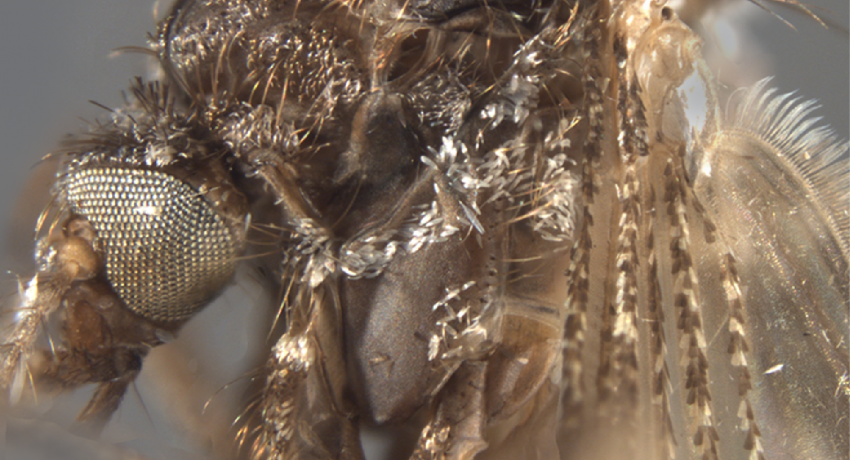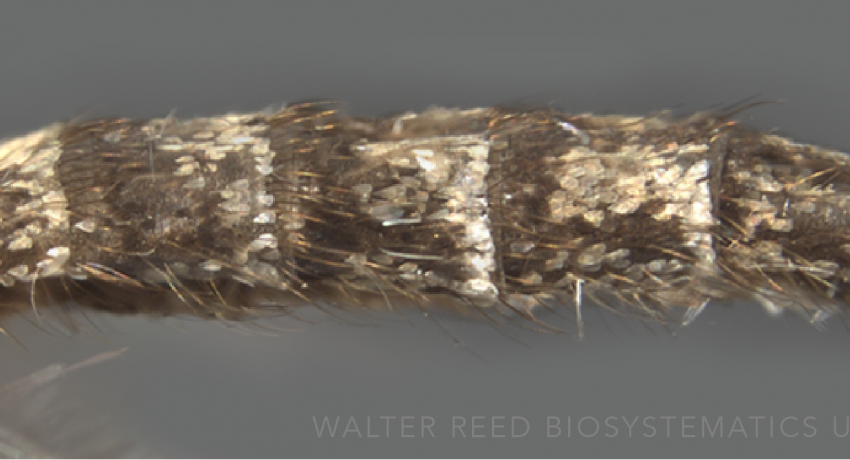NEARCTIC & NEOTROPICAL REGIONS
Etymology: not stated [of Columbia; possibly the New World or District of Columbia]
Psorophora columbiae are large floodwater mosquitos with an overall salt-and-pepper appearance from a spattering of broad white appressed scales adorning the pleura and abdominal segments. Psorophora columbiae is a member of the Ps. confinnis species complex.
Type locality: Grassymead, Virginia, United States
Type depository: U.S. National Museum, Washington D.C., United States (USNM)
DIAGNOSTIC CHARACTERS (Click photos to view; mouse over and click large photo to zoom in.)
ADULT (illustrated): Head: Proboscis with golden scales on distal half, apex dark; occiput with slender erect scales with notched tips. Thorax: Scutum with distinct median stripe of golden-brown scales along entire length; proepisternum without pale scales; lower mesepimeron with 5–11 setae; postprocoxal scales white. Wings: Wing scales narrow, brownish with inconspicuous pale scales intermixed on costal (C) and subcostal (Sc) veins and vein R1. Legs: Fe-III pale basally without preapical white band, with apical black scale tufts; U-I-III with distinct tooth basally.
LARVA (not illustrated): Head: Antenna short, not or barely reaching, front of head; head truncated anteriorally; Terminal segments: Spines of pecten long, ³15; seta 1-X short, 3,4 branched; comb scales illustrated.
TAXONOMIC KEYS
Carpenter & LaCasse 1955
Ross & Horsfall 1965
Bohart & Washino 1978
Becker et al. 2010
Harrison et al. 2016
Exemplar DNA sequences
Ps. columbiae COI: JX260111–12
BIONOMICS
Immatures
Psorophora overwinter as eggs are induced to hatch by inundation. Immatures are found in vegetation-rich temporary pools of accumulated rain water (sometimes brackish), with submerged and emergent grasses, especially rice fields. The aquatic life stage is short (4–10 days) allowing multiple generations per individual and rapid population booms in suitable conditions.
Adults
Males emerge several hours before the females, wait in the immatures habitats for the females to emerge, and mate almost immediately.
Psorophora columbiae are a severe nuisance—females bite incessantly throughout the day and night, and will attack all mammals in its vicinity, including cattle, people, rabbits, deer, and armadillos. Populations peak from mid-July to late August and at their highest densities, Ps. columbiae is known to cause deaths of adult cows through exsanguination, and of calves by suffocation. Females are readily captured in CDC and New Jersey light traps.
DISTRIBUTION NOTES
Bahamas, Belize, Canada, Cayman Islands, Cuba, Honduras, Mexico, Panama, United States (continental).

WRBU VECTOR HAZARD REPORTS
VHR: Mosquitoes of the Caribbean
View other WRBU Vector Hazard Reports
Available GIS Models:
None
IMPORTANT REFERENCES (full citations below)
Dyar & Knab 1906a: 135 (F; Janthinosoma)
Howard et al. 1913 (1912) (E*)
Howard et al. 1917: 590 (M*, F, P*, L*, E*)
Gerry 1932: 41 (F*)
Aitken 1940: 677 (taxonomy)
Horsfall 1942: 10 (bionomics)
Ross 1947: 91 (M*, F*, L*)
Yamaguti & LaCasse 1951b (F*)
Horsfall et al. 1952: 618 (E*)
Carpenter & LaCasse 1955: 129 (M*, F*, L*; keys; as confinnis)
Stone & Knight 1955: 283 (type information)
Craig, 1956 (E*, as confinnis)
Ross & Horsfall 1965 (M*, F*, L*, E*; keys; as confinnis)
Belkin et al. 1970: 137 (provisional resurrection)
Horsfall et al. 1970: 1714 (E*)
Bohart & Washino 1978: 37 (M*, F*, P*, L*; keys, taxonomy, bionomics, distribution)
Bosworth et al. 1983 (E*)
Linley & Chadee 1990 (E*)
Darsie & Ward 2005 (F*, L*; keys, distribution)
Becker et al. 2010: 394 (F*, L*; key, taxonomy, distribution, bionomics)
Lanzaro et al. 2015 (taxonomy)
Harrison et al. 2016 (F*, L*; keys, distribution)
CURRENT SYNONYMS
syn. floridense Dyar & Knab
1906a: 135 (A; Janthinosoma). Type locality: Alligator Creek, Florida, United States (USNM). References: Stone & Knight 1955: 283 (type information).
syn. texanum Dyar & Knab
1906a: 135 (A; Janthinosoma). Type locality: Brownsville, Texas, United States (USNM). References: Stone & Knight 1955: 286 (type information).
CITED REFERENCES
Aitken, T.H.G. (1940). The genus Psorophora in California (Diptera, Culicidae). Revista de Entomología, 11(3), 672–682.
Becker, N., Petrić, D., Zgomba, M., Boase, C., Madon, M., Dahl, C., & Kaiser, A. (2010). Mosquitoes and their control (Second ed.). Berlin Heidelberg: Springer-Verlag.
Belkin, J.N., Heinemann, S.J., & Page, W.A. (1970). The Culicidae of Jamaica (Mosquito studies. XXI). Contributions of the American Entomological Institute, 6(1), 458.
Bohart, R.M. & Washino, R.K. (1978). Mosquitoes of California (3rd ed.). Berkeley, CA: University of California, Agriculture and Natural Resources.
Bosworth, A. B., Meola, S. M., & Olson, J. K. (1983). The chorionic morphology of eggs of the Psorophora confinnis complex in the United States. 1. Taxonomic considerations. Mosquito Systematics, 15(4), 285–309.
Carpenter, S.J., & LaCasse, W.J. (1955). Mosquitoes of North America (North of Mexico). Berkeley, Los Angeles: University of California Press.
Craig Jr., G.B. (1956). Classification of eggs of nearctic Aedinae mosquitoes (Diptera: Culicidae). Dissertation Abstract (5)
Darsie, R.F., Jr., & Ward, R.A. (2005). Identification and geographical distribution of the mosquitoes of North America, north of Mexico. Gainesville, FL: University Press of Florida.
Dyar, H.G., & Knab, F. (1906a). Diagnoses of new species of mosquitoes. Proceedings of the Biological Society of Washington, 19, 133–142.
Gerry, B. I. (1932). Morphological studies of the female genitalia of Cuban mosquitoes. Annals of the Entomological Society of America, 25, 31–75.
Harrison, B.A., Byrd, B.D., Sither, C.B., & Whitt, P.B. (2016). The mosquitoes of the Mid-Atlantic Region: an identification guide (Vol. 1). Madison Heights, MI: Publishing XPress.
Horsfall, W.R. (1942). Biology and control of mosquitoes in the rice area. Bulletin of the Arkansas Experiment Station, 427, 1–46.
Horsfall, W.R., Miles, R.C., & Sokatch, J.T. (1952). Eggs of floodwater mosquitoes. I. Species of Psorophora (Diptera: Culicidae). Annals of the Entomological Society of America, 45(4), 618–624.
Horsfall, W.R., Voorhees, F.R., & Cupp, E.W. (1970). Eggs of floodwater mosquitoes. XIII. Chorionic sculpturing. Annals of the Entomological Society of America, 63, 1709–1716.
Howard, L.O., Dyar, H.G., & Knab, F. (1913). The mosquitoes of North and Central America and the West Indies. (Vol. II) (1912). Washington, D.C.: Carnegie Institution of Washington.
Howard, L.O., Dyar, H.G., & Knab, F. (1917). The mosquitoes of North and Central America and the West Indies. Systematic description. Part II. Washington, D.C.: Carnegie Institute of Washington.
Lanzaro, G.C., Coller, T.C., & Lee, Y. (2015). Defining genetic, taxonomic, and geographic boundaries among species of the Psorophora confinnis (Diptera: Culicidae) complex in North and South America. Journal of Medical Entomology, 52(5), 907–917.
Linley, J.R., & Chadee, D.D. (1990). Fine structure of the eggs of Psorophora columbiae, Ps. cingulata and Ps. ferox (Diptera: Culicidae). Proceedings of the Entomological Society of Washington, 92(3), 497–511.
Ross, H.H. (1947). The mosquitoes of Illinois (Diptera, Culicidae). Bulletin of the Illinois Natural History Survey, 24(1), 1–96.
Ross, H.H., & Horsfall, W.R. (1965). A synopsis of the mosquitoes of Illinois (Diptera, Culicidae). Illinois Natural History Survey Biological Notes, 52, 1–50.
Stone, A., & Knight, K.L. (1955). Type specimens of mosquitos in the United States National Museum: I. The genera Armigeres, Psorophora and Haemagogus (Diptera, Culicidae). Journal of the Washington Academy of Sciences, 282–289.
Yamaguti, S., & LaCasse, W. J. (1951b). Mosquito fauna of North America. Part III. Genera Orthopodomyia, Mansonia and Psorophora. Office of the Surgeon-General, Headquarters, 8th Army, APO 343. United States. 207th Malaria Survey Detachment.
CITE THIS PAGE
Walter Reed Biosystematics Unit (Year). Psorophora columbiae species page. Walter Reed Biosystematics Unit Website, http://wrbu.si.edu/vectorspecies/mosquitoes/columbiae, accessed on [date (e.g. 03 February 2020) when you last viewed the site].










































































































































































